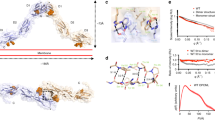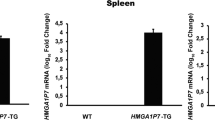Abstract
A partial cDNA sequence for the gene linked to the von Hippel–Lindau (VHL) syndrome was reported in 1993. Mutation or loss of both VHL alleles has been documented in sporadic renal cell carcinomas and in the neoplasms that arise in von Hippel–Lindau kindreds. We have determined that the protein product of the VHL gene is an approximately 30 kilodalton cytoplasmic protein. The renal carcinoma cell line 786-O is known to harbour a VHL mutation and, as shown here, fails to produce a wild-type VHL protein. Reintroduction of wild-type, but not mutant, VHL into these cells had no demonstrable effect on their growth in vitro but inhibited their ability to form tumours in nude mice.
This is a preview of subscription content, access via your institution
Access options
Subscribe to this journal
Receive 12 print issues and online access
$209.00 per year
only $17.42 per issue
Buy this article
- Purchase on Springer Link
- Instant access to full article PDF
Prices may be subject to local taxes which are calculated during checkout
Similar content being viewed by others
References
Malkin, D. et al. Germ line p53 mutations in a familial syndrome of breast cancer, sarcomas, and other neoplasms Science 250, 1233–1238 (1990).
McKusick, V.A. Inheritance in ManThe Johns Hopkins University Press, Baltimore and London,(1992).
Latif, F. et al. Identification of the von Hippel-Lindau disease tumor suppressor gene Science 260, 1317–1320 (1993).
Chen, F. et al. Germ line mutations in the von Hippel-Lindau disease tumor suppressor gene: Correlations with phenotype Hum. Mutat. 5, 66–75 (1995).
Shuin, T. et al. Frequent somatic mutations and loss of heterozygosity of the von Hippel-Lindau tumor suppressor gene in primary human renal cell carcinomas Cancer Res. 54, 2852–2855 (1994).
Gnarra, J.R. et al. Mutations of the VHL tumour suppressor gene in renal carcinoma. Nature Genet 7, 85–90 (1994).
Kanno, H. et al. Somatic mutations of the von Hippel-Lindau Tumor supressor gene in sporadic central nervous systems hemangioblastomas. Cancer Res. 54, 4845–4847 (1994).
Herman, J.G. et al. Silencing of the VHL tumor-suppressor gene by DNA methylation in renal carcinoma. Proc. natn. Acad. Sci. U.S.A. 91, 9700–9704 (1994).
Lathe, R. Synthetic oligonucleotide probes deduced from amino acid sequence data, theoretical and practical considerations. J. molec. Biol 183, 1–12 (1985).
Kuzmin, I. et al. Identification of the promoter of the human von Hippel-Lindau disease tumor suppressor gene. Oncogene (in the press).
Kozak, M. At least six nucleotides preceding the AUG initiator codon enhance translation in mammalian cells. J. molec. Biol 196, 947–950 (1987).
Kozak, M. The scanning model for translation: An update. J. Cell Biol 108, 229–241 (1989).
Shimizu, M. et al. Introduction of normal chromosome 3p modulates the tumori-genicity of a human renal cell carcinoma cell line YCR. Oncogene 5, 185–194 (1990).
Yoshida, M.A. et al. in vivo growth suppression and morphological change in a human renal cell carcinoma cell line by the introduction of normal chromosome 3 via microcell fusion. Molec. Carcinog. 9, 114–121 (1994).
Golde, D.W. & Hocking, W.G. Mechanisms and management. Ann. intern. Med. 95, 71–87 (1981).
Linehan, W.M., Lerman, M.I. & Zbar, B. Identification of the von Hippel-Lindau (VHL) gene. JAMA 273, 564–70 (1995).
Graham, F.L., Smiley, J., Russell, W.C. & Nairn, R. Characteristics of a human cell line transformed by DNA from human adenovirus type 5. J. Gen. Virol. 36, 59–72 (1977).
Graham, F.L. & van der Eb, A. A new technique for the assay of infectivity of human adenovirus 5 DNA. J. Virol. 52, 456–467 (1973).
Kaelin, W.G., Ewen, M.E. & Livingston, D.M. Definition of the minimal simian virus 40 large T antigen- and adenovirus E1A-binding domain in the retinoblastoma gene product. Molec. cell. Biol 10, 3761–3769 (1990).
DeCaprio, J.A. et al. SV40 large T antigen forms a specific complex with the product of the retinoblastoma susceptibility gene. Cell 54, 275–283 (1988).
Kaelin, W.G. et al. Expression cloning of a cDNA encoding a retinoblastoma-binding protein with E2F-like properties. Cell 70, 351–364 (1992).
Krek, W., Livingston, D.M. & Shirodkar, S. Binding to DNA and retinoblastoma gene product promoted by complex formation of different E2F family members. Science 262, 1557–1560 (1993).
Smith, D.B. & Johnson, K.S. Single-step purification of polypeptides expressed in Escherichia coli as fusions with glutathione S-transferase. Gene 67, 31–40 (1988).
Qin, X.-Q., Livingston, D.M., Kaelin, W.G. & Adams, P. Deregulated E2F1 expression leads to S-phase entry and p53-mediated apoptosis. Proc. natn. Acad. Sci. U.S.A. 91, 10918–10922 (1994).
Qin, X.-Q. et al. The transcription factor E2F1 is a downstream target of RB action. Molec. cell. Biol 15, 742–755 (1995).
Harlow, E. & Lane, D. Antibodies —A laboratory manual (Cold Spring Harbor Laboratory, Cold Spring Harbor, New York, 1988).
Lee, W.-H. et al. The retinoblastoma susceptibility gene encodes a nuclear phosphoprotein associated with DNA binding activity. Nature 329, 642–645 (1987).
Radke, K.V. et al. Membrane association of a 36,000-Dalton substrate for tyro-sine phosphorylation in chicken embryo fibroblasts transformed by avian sarcoma viruses. J. cell Biol 97, 1601–1611 (1983).
Qin, X.-Q., Chittenden, T., Livingston, D.M. & Kaelin, W.G. Identification of a growth suppression domain within the retinoblastoma gene product. Genes Dev. 6, 953–964 (1992).
Chomczynski, P. & Sacchi, N. Single step method of RNA isolation by acid guadinium thiocyanate-phenol-chloroform extraction. Anal. Biochem. 162, 156–159 (1987).
Author information
Authors and Affiliations
Rights and permissions
About this article
Cite this article
Iliopoulos, O., Kibel, A., Gray, S. et al. Tumour suppression by the human von Hippel-Lindau gene product. Nat Med 1, 822–826 (1995). https://doi.org/10.1038/nm0895-822
Received:
Accepted:
Issue Date:
DOI: https://doi.org/10.1038/nm0895-822
This article is cited by
-
Targeting ferroptosis as a vulnerability in cancer
Nature Reviews Cancer (2022)
-
The close interaction between hypoxia-related proteins and metastasis in pancarcinomas
Scientific Reports (2022)
-
Differential effects of HIF2α antagonist and HIF2α silencing in renal cancer and sensitivity to repurposed drugs
BMC Cancer (2021)
-
Selective and noncovalent targeting of RAS mutants for inhibition and degradation
Nature Communications (2021)
-
VHL suppresses RAPTOR and inhibits mTORC1 signaling in clear cell renal cell carcinoma
Scientific Reports (2021)



